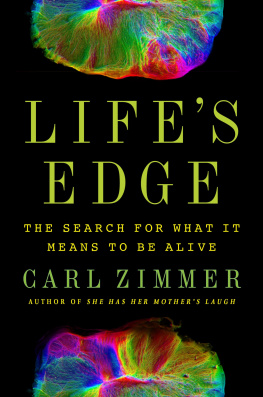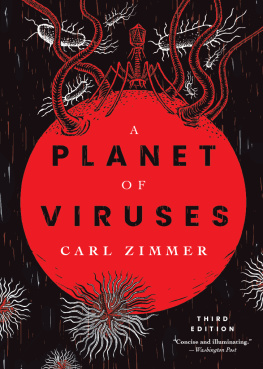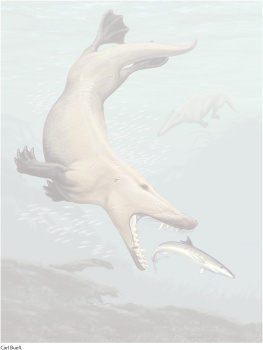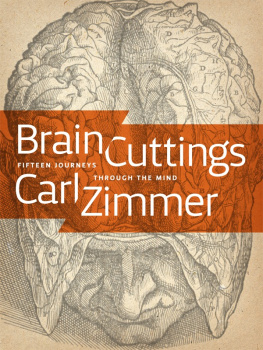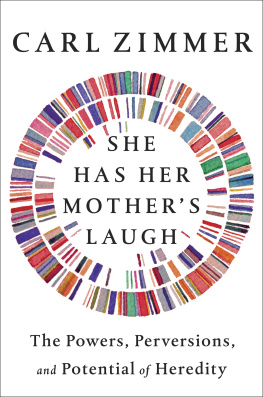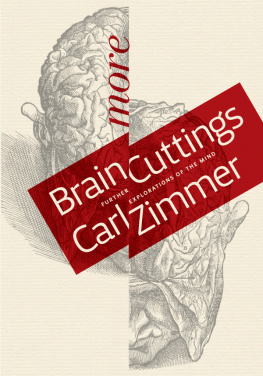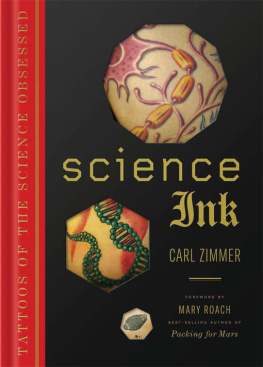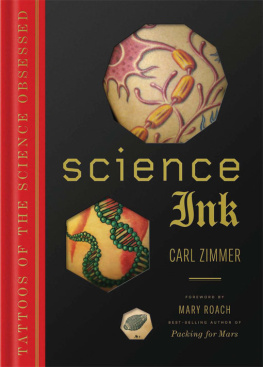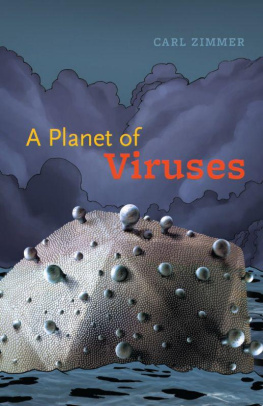Carl Zimmer - Lifes Edge: The Search for What It Means to Be Alive
Here you can read online Carl Zimmer - Lifes Edge: The Search for What It Means to Be Alive full text of the book (entire story) in english for free. Download pdf and epub, get meaning, cover and reviews about this ebook. year: 2021, publisher: Penguin Publishing Group, genre: Detective and thriller. Description of the work, (preface) as well as reviews are available. Best literature library LitArk.com created for fans of good reading and offers a wide selection of genres:
Romance novel
Science fiction
Adventure
Detective
Science
History
Home and family
Prose
Art
Politics
Computer
Non-fiction
Religion
Business
Children
Humor
Choose a favorite category and find really read worthwhile books. Enjoy immersion in the world of imagination, feel the emotions of the characters or learn something new for yourself, make an fascinating discovery.
- Book:Lifes Edge: The Search for What It Means to Be Alive
- Author:
- Publisher:Penguin Publishing Group
- Genre:
- Year:2021
- Rating:5 / 5
- Favourites:Add to favourites
- Your mark:
- 100
- 1
- 2
- 3
- 4
- 5
Lifes Edge: The Search for What It Means to Be Alive: summary, description and annotation
We offer to read an annotation, description, summary or preface (depends on what the author of the book "Lifes Edge: The Search for What It Means to Be Alive" wrote himself). If you haven't found the necessary information about the book — write in the comments, we will try to find it.
Lifes Edge: The Search for What It Means to Be Alive — read online for free the complete book (whole text) full work
Below is the text of the book, divided by pages. System saving the place of the last page read, allows you to conveniently read the book "Lifes Edge: The Search for What It Means to Be Alive" online for free, without having to search again every time where you left off. Put a bookmark, and you can go to the page where you finished reading at any time.
Font size:
Interval:
Bookmark:

She Has Her Mothers Laugh
A Planet of Viruses
Evolution: Making Sense of Life
The Tangled Bank
Science Ink
Brain Cuttings
The Descent of Man: The Concise Edition
Microcosm
Soul Made Flesh
Evolution: The Triumph of an Idea
Parasite Rex
At the Waters Edge


An imprint of Penguin Random House LLC
penguinrandomhouse.com
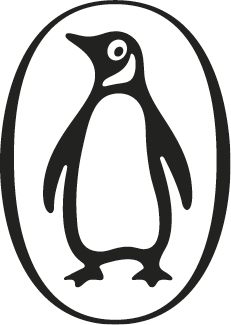
Copyright 2021 by Carl Zimmer
Penguin supports copyright. Copyright fuels creativity, encourages diverse voices, promotes free speech, and creates a vibrant culture. Thank you for buying an authorized edition of this book and for complying with copyright laws by not reproducing, scanning, or distributing any part of it in any form without permission. You are supporting writers and allowing Penguin to continue to publish books for every reader.
DUTTON and the D colophon are registered trademarks
library of congress cataloging-in-publication data
Names: Zimmer, Carl, 1966 author. Title: Lifes edge : the search for what it means to be alive / Carl Zimmer.
Description: New York : Dutton, an imprint of Penguin Random House LLC, [2021] | Includes bibliographical references and index.
Identifiers: LCCN 2020039762 (print) | LCCN 2020039763 (ebook) | ISBN 9780593182710 (hardcover) | ISBN 9780593182727 (ebook)
Subjects: LCSH: Life sciences. | Life (Biology)
Classification: LCC QH311 .Z56 2021 (print) | LCC QH311 (ebook) | DDC 570dc23
LC record available at https://lccn.loc.gov/2020039762LC ebook record available at https://lccn.loc.gov/2020039763
While the author has made every effort to provide accurate telephone numbers, internet addresses, and other contact information at the time of publication, neither the publisher nor the author assumes any responsibility for errors or for changes that occur after publication. Further, the publisher does not have any control over and does not assume any responsibility for author or third-party websites or their content.
Cover photo MRC Laboratory of Molecular Biology/Madeline Lancaster
pid_prh_5.6.1_c0_r0
To Grace, my love and life
THE BORDERLAND
In the fall of 1904, the Cavendish Laboratory was full of curious experiments. Clouds of mercury shuddered with flashes of blue light. Lead cylinders pirouetted on copper disks. The ivy-covered building on Free School Lane, nestled in the heart of Cambridge, was the most exciting place for physicists to be, not just in England but in the entire world, a place where they could toy with the fundamental pieces of the universe. Amidst this forest of magnets and vacuums and batteries, it would have been easy to overlook one small experiment sitting forlornly by itself. It consisted of little more than a glass tube capped with cotton, half-filled with a few spoonfuls of brown broth.
But something was coming into being in that tube. In a few months the world would collectively gasp at it. Newspapers would celebrate the experiment as one of the most remarkable achievements in the history of science. One reporter would describe what lurked in the tube as the most primitive form of lifethe missing link between the inorganic and organic worlds.
This most primitive life was the creation of a thirty-one-year-old physicist named John Butler Burke. In photographs from around the time of the experiment, Burkes boyish face has a melancholy cast. He was born in Manila to a Filipino mother and an Irish father. As a boy he traveled to Dublin for schooling and ended up at Trinity College, where he studied X-rays, dynamos, and the mysterious sparks released by sugar. Trinity awarded Burke a gold medal in physics and chemistry. One professor described him as a man who is gifted with the power of exciting in others the enthusiasm which he brings to bear upon his own lines of investigation. After finishing his studies, Burke moved from Dublin to England to teach at a series of universities. His father soon died and his motheran old lady of very large means, as Burke later called hersupported him with a generous allowance. In 1898, Burke joined the Cavendish.
Nowhere on Earth had physicists learned so much in so little time about matter and energy. Their most recent triumph, courtesy of the labs director, Joseph John Thomson, was the discovery of the electron. In his first few years at the Cavendish, Burke followed up on Thomsons work by running experiments of his own on the mysterious charged particles, investigating how electrons could light up clouds of gas. But then a new mystery lured him away. Like many other young physicists at the Cavendish, Burke started experimenting with a glowing new element called radium.
A few years beforehand, in 1896, a French physicist named Henri Becquerel had discovered the first evidence that ordinary matter could cast off a strange form of energy. When he wrapped uranium salts in a black cloth, they created a ghostly image on a photographic plate nearby. It soon became clear that the uranium was steadily releasing some kind of potent particle. To follow up on Becquerels work, Marie and Pierre Curie extracted uranium from an ore called pitchblende. In the process, they discovered that some of the energy was coming from a second element. They named it radium and christened its new form of energy radioactivity.
Radium unleashed so much energy that it could keep itself warm. If scientists set a piece atop a block of ice, it could melt its own weight in water. When the Curies mixed radium with phosphorus, the particles unleashed by the radium made the phosphorus glow in the dark. As news of this rare, exotic substance spread, it became a sensation. In New York, dancers put on radium-coated outfits to perform in darkened casinos. People wondered if radium would become a mainstay of civilization. Are we about to realize the chimerical dream of the alchemistslamps giving light perpetually without the consumption of oil? one chemist mused. Radium also seemed to have a vitalizing power. Gardeners sprinkled it on their flowers, convinced it could make them grow bigger. Some people drank liquid sunshine to cure all manner of ills, including even cancer.
It was cancer that would eventually claim Marie Curies life in 1934, probably because of the radium and other radioactive elements she worked with on a daily basis. Now that we understand the deadly risk posed by radioactivity, its hard to imagine how anyone could think that radium could have vitalizing powers. But in the early 1900s scientists knew surprisingly little about the nature of life. The best they could say was that its essence lurked in the jellylike substance in cells, a material they called protoplasm. It somehow organized cells into living things and was passed down from one generation to the next. Beyond that, little was certain and all manner of ideas were viable.
To Burke, life and radioactivity displayed a profound similarity. Like a caterpillar becoming a moth, a radium atom could undergo a transformation that seemed to come from within. It changes its substancein a limited sense it livesand yet it is ever the same, Burke declared in a 1903 magazine article. The distinction, apparently insuperable, that the biologist holds to exist between living and so-called dead matter, should thus pass away as a false distinction... All matter is alivethat is my thesis.
Font size:
Interval:
Bookmark:
Similar books «Lifes Edge: The Search for What It Means to Be Alive»
Look at similar books to Lifes Edge: The Search for What It Means to Be Alive. We have selected literature similar in name and meaning in the hope of providing readers with more options to find new, interesting, not yet read works.
Discussion, reviews of the book Lifes Edge: The Search for What It Means to Be Alive and just readers' own opinions. Leave your comments, write what you think about the work, its meaning or the main characters. Specify what exactly you liked and what you didn't like, and why you think so.

